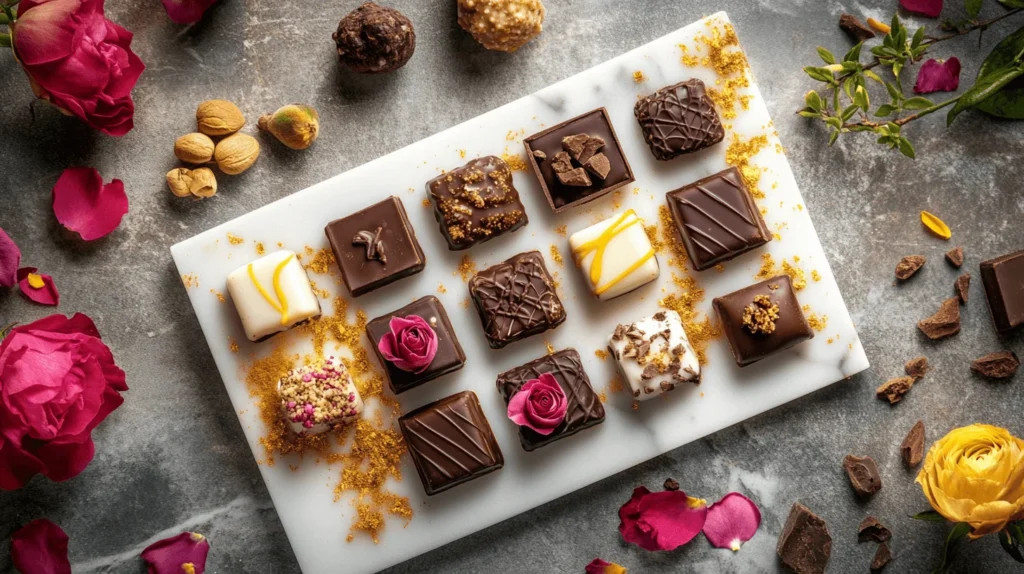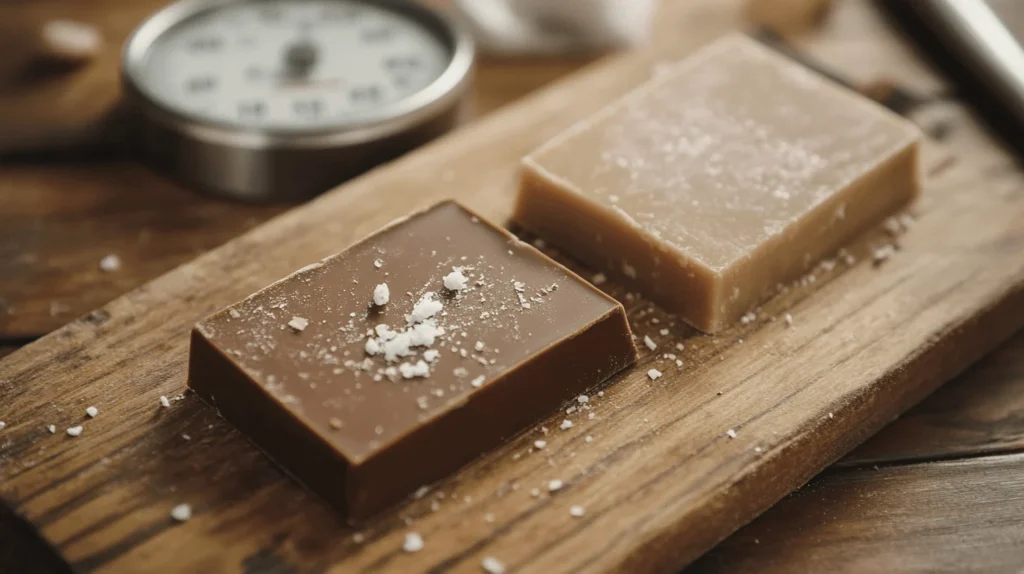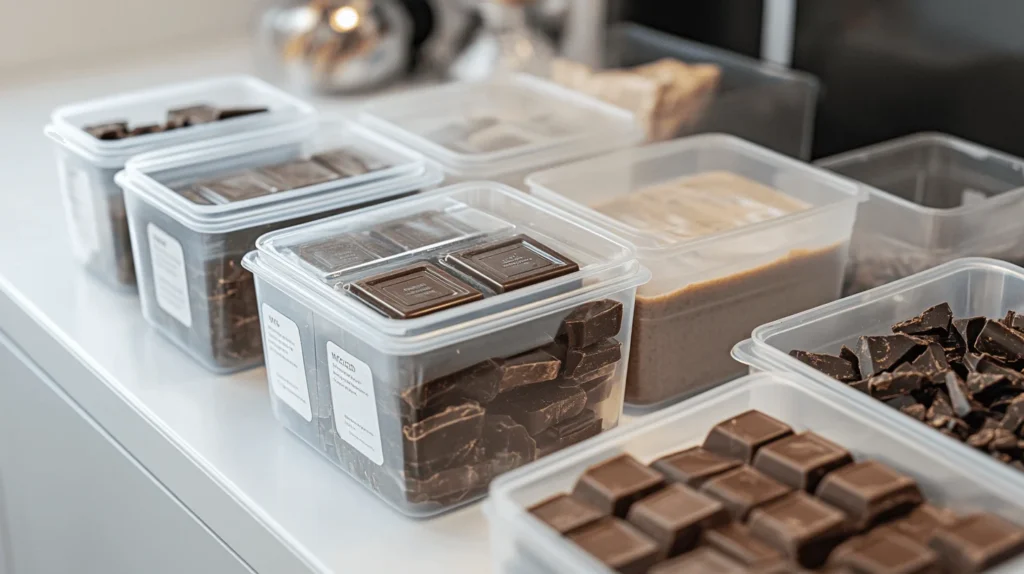Chocolate lovers often grapple with the dilemma of how to store their sweet treasures, and Dubai chocolate is no exception. Known for its luxurious quality and rich taste, Dubai chocolate deserves the best care to maintain its integrity. This guide will unravel the mysteries of chocolate storage, delve into the science of preservation, and address whether refrigerating Dubai chocolate is a good idea. From understanding its unique characteristics to practical tips, we’ve got everything you need to keep your chocolate fresh and flavorful.
Understanding Dubai Chocolate: Quality and Characteristics
What Makes Dubai Chocolate Unique?

Dubai chocolate is a delightful fusion of premium ingredients and artistic craftsmanship. Unlike generic chocolates, it often includes exotic flavors like saffron, rose, or camel milk, adding a regional flair to its taste. The use of high-quality cocoa and unique formulations ensures its rich, velvety texture and intense flavor. To understand more about this premium confection, visit What Is So Special About Dubai Chocolate.
The Role of Ingredients in Shelf Stability
The ingredients in Dubai chocolate play a significant role in determining how long it stays fresh. High cocoa butter content, common in artisanal chocolate, makes it sensitive to temperature changes. Additionally, flavoring agents like nuts and dried fruits can affect its shelf life. Proper storage techniques ensure these elements don’t lose their potency or compromise the chocolate’s overall quality.
How Climate Influences Chocolate Storage Needs
Dubai’s climate, marked by scorching summers and high humidity, poses unique challenges for chocolate storage. Extreme heat can cause chocolate bloom—a whitish coating that alters its texture and taste. On the other hand, excessive humidity can lead to moisture absorption, further degrading the chocolate. Learn more about how climate impacts chocolate in Does Dubai Chocolate Need to Be Refrigerated?.
The Science of Chocolate Storage

How Temperature Affects Chocolate Texture and Flavor
Chocolate is a delicate treat, and temperature plays a key role in maintaining its quality. If exposed to high heat, the cocoa butter in chocolate melts unevenly, causing chocolate bloom, an unappealing white or grayish layer on the surface. While bloom doesn’t make chocolate unsafe to eat, it can ruin the texture and flavor, leaving you disappointed. This brings us back to the question: Do I refrigerate Dubai chocolate? The answer lies in understanding how to prevent these undesirable changes.
Conversely, storing chocolate at low temperatures, like in a refrigerator, can also be problematic. Sudden shifts from cold to warm environments create condensation, which leads to moisture accumulation and texture degradation. Maintaining a stable temperature is critical for preserving the silky smoothness and rich flavor of Dubai chocolate.
Humidity: A Key Factor in Chocolate Preservation
Humidity is chocolate’s nemesis. High humidity levels can cause sugar bloom, a phenomenon where moisture interacts with sugar, leaving a grainy residue on the surface. Dubai’s climate, known for its extreme heat and humidity, makes this issue particularly relevant. To avoid this, it’s essential to keep chocolate in a dry, controlled environment. For insights into combating storage challenges, check out Why Is Dubai Chocolate So Expensive? The Secrets Behind Luxury Chocolate Pricing.
By addressing both temperature and humidity, you can protect Dubai chocolate’s luxurious qualities. But before rushing to refrigerate it, consider whether alternative solutions might work better for your climate.
The Ideal Storage Conditions for Chocolate
So, what are the ideal conditions for chocolate? Experts recommend keeping chocolate at a consistent temperature between 60–68°F (16–20°C) with low humidity. A cool pantry or cupboard, away from sunlight and strong odors, often works best. If your home gets too warm, you might wonder, Do I refrigerate Dubai chocolate? While refrigeration is an option, it’s not the first choice due to its potential impact on quality.
Do You Need to Refrigerate Dubai Chocolate?
Situations Where Refrigeration May Be Necessary
While refrigeration isn’t ideal for chocolate, there are instances when it becomes unavoidable. For example, during Dubai’s sweltering summers, when indoor temperatures soar, refrigerating chocolate may be the only way to prevent it from melting. However, it’s essential to store chocolate in an airtight container to shield it from moisture and refrigerator odors.
Another scenario where refrigeration might be necessary is when you’re dealing with specialty chocolates that contain fresh fillings, like cream or fruit. These types of chocolates have shorter shelf lives and must be kept cold to avoid spoilage.
Why Refrigeration Can Sometimes Harm Chocolate Quality
Refrigeration might solve one problem but create another. When chocolate is removed from the fridge, it can develop condensation as it warms up. This moisture can lead to sugar bloom, leaving your chocolate with a chalky appearance and altered taste. Moreover, the cold temperature can dull the complex flavors of Dubai chocolate, robbing you of its signature richness.
Instead of refrigerating, consider using cooling packs or insulated containers to maintain a moderate temperature without exposing the chocolate to excessive cold. This strikes a balance between preventing melting and preserving quality.
Alternative Storage Solutions for Hot Climates
If refrigeration isn’t ideal, what’s the alternative? For residents in Dubai or other hot climates, investing in a wine fridge or a climate-controlled pantry can be a game-changer. These solutions provide stable, cool temperatures without the drawbacks of traditional refrigerators.
Another option is to use double-wrapped airtight containers, which help protect chocolate from humidity and odor contamination. Pair these containers with desiccant packets to minimize moisture buildup. By taking these precautions, you can ensure your Dubai chocolate remains as delectable as the day you bought it.
Practical Tips for Storing Dubai Chocolate

Best Practices for Storing Chocolate Without Refrigeration
If you’re wondering, Do I refrigerate Dubai chocolate? the answer might surprise you. For most types of chocolate, refrigeration isn’t the ideal solution. Instead, store it in a cool, dry spot away from sunlight. A pantry or cupboard that stays below 68°F (20°C) works wonders.
Avoid storing chocolate near strong-smelling foods like spices or onions, as it can easily absorb odors. Also, use airtight containers to protect it from both air and humidity. These small adjustments can make a big difference in keeping your Dubai chocolate fresh and flavorful.
Using Airtight Containers and Cooling Packs
When temperatures rise, airtight containers become your chocolate’s best friend. They shield chocolate from moisture, air, and odors, making them essential for warm climates. Pair these containers with cooling packs if your kitchen gets too hot. Just make sure the cooling packs don’t come into direct contact with the chocolate to avoid condensation.
Cooling packs work especially well during travel or in homes without air conditioning. By using these simple tools, you can keep your chocolate from melting without sacrificing its texture or taste.
Avoiding Common Storage Mistakes
There are a few pitfalls to avoid when storing Dubai chocolate. First, don’t leave it in the fridge without protection—moisture and odors can wreak havoc. Second, never store it in a freezer; the extreme cold can ruin its smooth texture and create cracks.
Lastly, resist the urge to open and close the container frequently. Each time you do, warm air rushes in, potentially causing condensation. A little extra care goes a long way in maintaining chocolate’s quality.
Common Misconceptions About Chocolate Storage
Does All Chocolate Need Refrigeration?
It’s a common belief that all chocolate needs refrigeration, especially in warm climates. However, this isn’t entirely true. Most solid chocolate, including Dubai chocolate, thrives at room temperature as long as the environment is cool and dry. Refrigerating unnecessarily can lead to sugar bloom or texture changes. So, the next time you think, Do I refrigerate Dubai chocolate? consider its type and the local climate before making a decision.
Freshly filled chocolates or those containing dairy, like truffles or cream-filled treats, are exceptions. These types need refrigeration to prevent spoilage, but even then, extra care is needed to avoid moisture damage.
Will Refrigeration Always Harm Chocolate?
While it’s true that refrigeration isn’t ideal for most chocolate, it doesn’t always spell disaster. When done correctly—by using airtight containers and avoiding temperature swings—refrigeration can help preserve chocolate during extremely hot conditions. The key is ensuring that the chocolate is gradually acclimated to room temperature before eating to prevent condensation.
For instance, refrigerating Dubai chocolate during summer can save it from melting, but this should always be a last resort. Understanding these nuances can help you avoid the pitfalls of improper storage.
How Chocolate Storage Impacts Taste and Quality
Does Storage Affect Chocolate’s Flavor?
Yes, how you store chocolate significantly impacts its flavor. When chocolate absorbs odors from the environment, such as garlic or spices, its taste can change dramatically. Similarly, if it’s exposed to moisture, the delicate balance of flavors can be lost. Proper storage, especially in airtight containers, is essential for preserving the signature richness of Dubai chocolate.
If you’re still asking, Do I refrigerate Dubai chocolate? remember that refrigeration can mute the chocolate’s complex flavors. Allowing it to return to room temperature slowly before eating helps restore some of its original taste, but it’s always better to store it properly to begin with.
What Role Does Temperature Play in Quality?
Temperature doesn’t just affect the texture of chocolate—it also determines its overall quality. Extreme heat can cause melting, while prolonged exposure to cold can make chocolate brittle. Dubai chocolate, known for its smooth texture, deserves to be stored in conditions that protect its craftsmanship. Maintaining a steady temperature in the recommended range ensures your chocolate remains as indulgent as intended.
Striking a Balance in Chocolate Storage
Summary of Key Points
When it comes to the question, Do I refrigerate Dubai chocolate? the answer isn’t always straightforward. Proper storage depends on factors like temperature, humidity, and the type of chocolate. For the best results, aim to store your chocolate in a cool, dry spot between 60–68°F (16–20°C). While refrigeration can be helpful in extremely hot climates, it’s crucial to use airtight containers to protect the chocolate from moisture and odors.
We’ve also discussed practical storage solutions, such as using cooling packs and airtight containers, and highlighted the risks of common mistakes like frequent temperature changes or freezer storage. By taking these steps, you can ensure your Dubai chocolate remains as delicious and luxurious as intended.
Final Recommendations Based on Climate and Chocolate Type
For residents in hot climates like Dubai, storage can be a challenge, but it’s not impossible. If you can maintain a stable, cool environment with the help of a wine fridge or insulated storage, you may not need to refrigerate your chocolate. However, for chocolates with fresh fillings or during peak summer months, refrigeration may be the best option—just be sure to follow the right precautions.
FAQs
How to store Dubai chocolate?
Dubai chocolate should be stored in a cool, dry place, ideally between 60–68°F (16–20°C). Use an airtight container to protect it from humidity and strong odors. Keep it away from direct sunlight and avoid frequent temperature changes to maintain its quality. If the environment is too warm, consider using a wine fridge or cooling packs as an alternative to regular refrigeration.
What Happens If Chocolate Is Stored Incorrectly?
Improperly stored chocolate can suffer from bloom, develop off-flavors, or lose its smooth texture. If exposed to fluctuating temperatures or high humidity, even the finest Dubai chocolate can degrade. Fortunately, following storage guidelines can help you avoid these issues and extend your chocolate’s shelf life.
Is chocolate safe to eat if not refrigerated?
Yes, most chocolate, including Dubai chocolate, is safe to eat without refrigeration as long as it’s stored in proper conditions. Solid chocolates can last for months at room temperature if kept away from heat, moisture, and strong odors. However, chocolates with fresh fillings or dairy ingredients should be refrigerated to avoid spoilage.
How long can you keep the Dubai chocolate for?
The shelf life of Dubai chocolate depends on its type. Solid chocolates can last 6–12 months when stored correctly, while those with fresh fillings, like cream or fruit, typically need to be consumed within a few weeks. Always check the packaging for specific expiration dates and storage recommendations.
Conclusion
Storing Dubai chocolate properly is as much an art as it is a science. The answer to the question Do I refrigerate Dubai chocolate? depends on various factors like the type of chocolate, the climate, and the storage options available. While refrigeration can be helpful in extreme conditions, it’s often not the best choice for maintaining the flavor, texture, and overall quality of chocolate.
Ultimately, by understanding the unique characteristics of Dubai chocolate and the challenges of storing it in different environments, you can ensure your sweet indulgence stays as delightful as the day you bought it. Whether you’re savoring it yourself or gifting it to someone special, proper storage will always make a world of difference.





